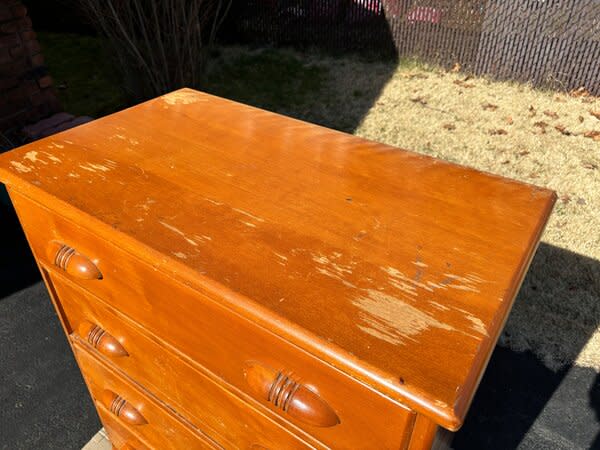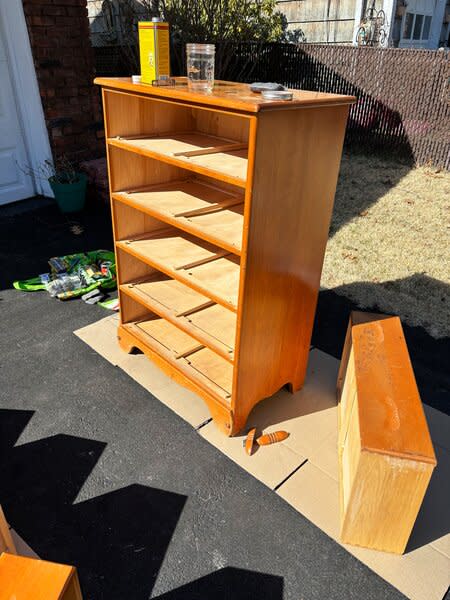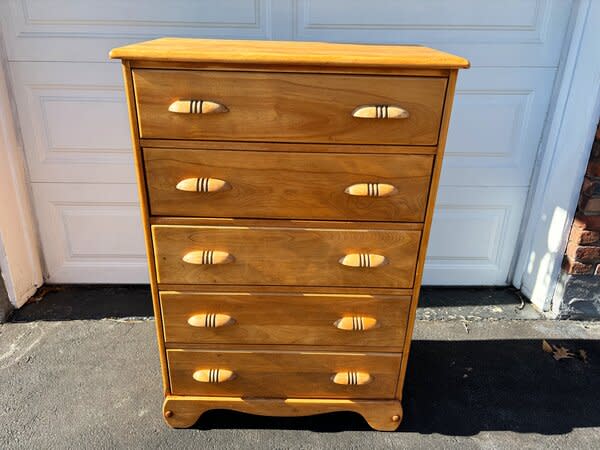Social Media Convinced Me to Refinish a Dresser. I Lived to Tell the Tale
All it took was an orbital sander, some elbow grease, and determination to see it through.

At some point in the last few years, my TikTok and Instagram Reels algorithms started serving me the DIY equivalent of Dr. Pimple Popper videos: mesmerizing footage of chatty, confident people applying chemical stripper to run-down old wooden furniture with good bones and reviving it into something gorgeous and classic. Despite knowing perfectly well that social media is full of B.S., it convinced me that it wouldn’t be so hard to start refinishing vintage wood furniture. It would be soothing, really, and all those chemicals would practically do the work for me. How hard could it be?
Well, it certainly wasn’t soothing. But it was worth it.
Selecting my victim
I really needed another dresser, and I didn’t want to pay a couple hundred bucks for some piece of fast furniture garbage that would just fall apart over the next three years. I wanted something made to last, out of honest-to-God wood rather than particleboard, and on my budget, that meant secondhand. And so after weeks of lurking in my local thrift stores and stalking Facebook Marketplace, I finally spotted the perfect candidate on my local Buy Nothing group—a chest height dresser with five drawers, with wooden pulls to match.
It was a bit weathered and the existing finish was orange and almost opaque to the point you could barely see the wood grain. But the bones were beautiful—a solid maple without any veneer to complicate the refinishing project. There was a maker’s mark from French & Heald of New Hampshire, and a quick survey of the Internet suggested that I wouldn’t be running the risk of ruining some priceless piece of decorative art. Besides, if I didn’t take the thing, it was going in the garbage and, ultimately, the landfill. Worst case scenario, I’d slink back to Buy Nothing with my tail between my legs and offer it up to somebody handier.
I snapped it up and went to work.
Gathering my supplies—and my nerve
Initially, I had pictured smearing the dresser with Citristrip stripping gel—a sickly orange substance popular with TikTokers—waiting 30 minutes, and then scraping away decades’ worth of old goop. Instead, after a panicked moment in the aisle of the hardware store, I grabbed a tin of Minwax Antique Furniture Refinisher, something that I’d encountered when doing some background reading. And so my dreams of sloughing off the hideous orange were dashed through my own decisions. After actually reading the back of the tin, I poured some into a mason jar and used a piece of steel wool like a sponge, rubbing away the original finish with a whole lot of elbow grease. (I did this outside, to protect against the chemical fumes; it was only later that I learned I probably should have been more careful to keep the whole project out of direct sunlight, to avoid uneven discoloration.)
I worked for an hour and a half before I had to take a break for more Minwax; I then spent another hour and a half at work and finally accepted that the project wasn’t going to be done in one day, or even one weekend. After a couple hours of trial and error, I realized the best move was to go to town on the dresser for a few minutes with the Minwax-saturated steel wool and then, before the Minwax evaporated, take an old rag and wipe off whatever had come up.
After several more rounds with the stripper and the steel wool, I could quickly see the wood grain emerging, and a color much closer to honey than orange paint. But on my third tin of refinisher, I accepted that sanding by hand wasn’t going to be enough to remove the stubborn traces of the old varnish. I threw in the goop-stained towel and ordered a small SKIL orbital sander for around $30.
My only regret is that I didn’t buy the sander earlier in the process, because it quickly stripped off the stubborn, blotchy traces of whatever the original finish was and exposed the beautiful maple underneath. (Buy more sandpaper sheets than you think you need, though.) If I had just started with the sander, I could have had this project done a full week earlier. Hindsight, as they say, is 20/20.
Bring it on home
Once I’d sanded off the last of the old finish, the bare wood suddenly looked awfully light. At the same time, the Minwax Wood Finish in Colonial Maple I’d originally bought looked like it might wind up a bit yellow, and apparently maple is particularly difficult to stain evenly. But my internet research suggested polyurethane might yellow over time, as well, like a golden oak kitchen. I considered a matte topcoat to avoid a plasticky shine and various wood oils in hopes of a more antique-like effect. I even went to a local paint store to investigate in person.
Finally, I just decided to quit dithering and go with the poly I’d already bought. Sometimes, you just have to make a decision and see how it plays out.
I applied Minwax fast-drying polyurethane (in warm satin), in the thinnest of coats with a foam brush, to minimize the chances of imperfections. Nevertheless, I found myself in a constant struggle against bubbles. (Water-based may have been more forgiving.) One drawer definitely has a thicker coating than the others. An errant piece of fuzz, blown in from the open garage door, was nearly permanently embedded in the finish on another, but I managed to sand it out between coats.
Will I do this again?
See the full story on Dwell.com: Social Media Convinced Me to Refinish a Dresser. I Lived to Tell the Tale




